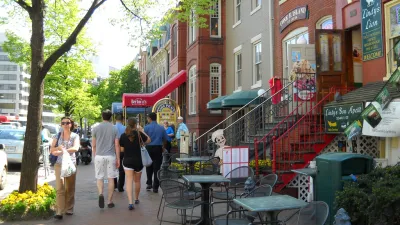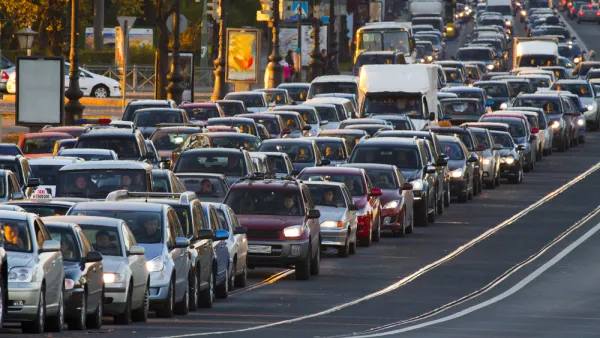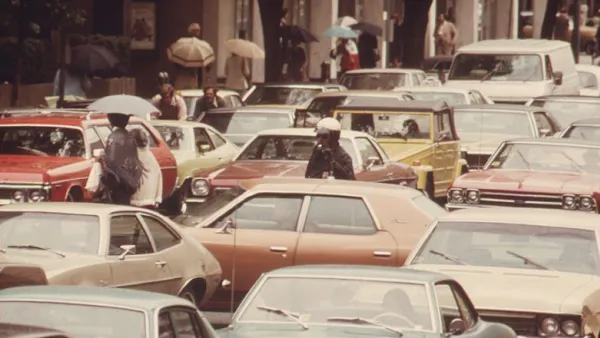Is there a relationship between carless households and density of college graduates? Derek Thompson of The Atlantic connected the dots using Michael Sivak's latest 'peak car' study and saw a relationship between the two variables.

"The members of the The Atlantic Business Channel (where Derek Thompson works as a senior editor) all live in New York City. At various points in our lives, we have all lived in Washington, D.C., too. And these two cities...happen to be the two metros with the highest share of non-car households in America, according to the University of Michigan’s Transportation Research Institute," writes Thompson.
When Thompson looked at the graph (located in the article) of the 30 cities showing which metros have the highest and lowest rates of "non-car households" (as well as the U.S. average), the first thing he thought of was not what the researcher told The Wall Street Journal:
The five cities with the highest proportions of households without a vehicle were all among the top five cities in a recent ranking of the quality of public transportation," said Michael Sivak, director of Sustainable Worldwide Transportation at Michigan.
"When I see New York, D.C., Boston, Philadelphia, San Francisco [the top-five, respectively, no-car households], the first thing I think is: These are all the classic, even cliche, magnets for elite college graduates," he wrote.
So I compared the cities' non-car ownership rates to their share of bachelor's-degree holders. And it turns out there is a statistically significant relationship between being college-dense and car-light. [Scroll across the interactive dot graph (under the aforementioned graph in article) that reveals "% no-car, % college"]
Thompson recognizes that "what we're looking at here is an underlying variable of city density. Highly productive cities that are magnets for talented (and rich) people tend to be crowded with twentysomethings trying to start their careers. Small crowded cities get clogged, and clogged cities require the kind of effective public transportation that makes cars an expensive nice-to-have rather than a have-to-have," he writes.
The theory doesn't appear to hold, though, for Austin and San Jose, the major city of Silicon Valley, ranked third-to-last and last, respectively, in the ranking of carless households.
Sivak's report, "Has Motorization in the U.S. Peaked? Part 4: Households without a Light-Duty Vehicle" [PDF] was discussed here and also in USA Today.
FULL STORY: Why Do the Smartest Cities Have the Smallest Share of Cars?

National Parks Layoffs Will Cause Communities to Lose Billions
Thousands of essential park workers were laid off this week, just before the busy spring break season.

Retro-silient?: America’s First “Eco-burb,” The Woodlands Turns 50
A master-planned community north of Houston offers lessons on green infrastructure and resilient design, but falls short of its founder’s lofty affordability and walkability goals.

Delivering for America Plan Will Downgrade Mail Service in at Least 49.5 Percent of Zip Codes
Republican and Democrat lawmakers criticize the plan for its disproportionate negative impact on rural communities.

Test News Post 1
This is a summary

Test News Headline 46
Test for the image on the front page.

Balancing Bombs and Butterflies: How the National Guard Protects a Rare Species
The National Guard at Fort Indiantown Gap uses GIS technology and land management strategies to balance military training with conservation efforts, ensuring the survival of the rare eastern regal fritillary butterfly.
Urban Design for Planners 1: Software Tools
This six-course series explores essential urban design concepts using open source software and equips planners with the tools they need to participate fully in the urban design process.
Planning for Universal Design
Learn the tools for implementing Universal Design in planning regulations.
EMC Planning Group, Inc.
Planetizen
Planetizen
Mpact (formerly Rail~Volution)
Great Falls Development Authority, Inc.
HUDs Office of Policy Development and Research
NYU Wagner Graduate School of Public Service




























